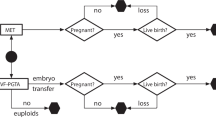Abstract
Marfan syndrome (MFS) is caused by a FBN1 mutation. Many organ systems are affected in patients with MFS, including the skeletal, ocular, cardiovascular and pulmonary systems. Cardiovascular manifestations are the main cause of mortality in patients with MFS. The mode of inheritance of MFS is autosomal dominant inheritance and the offspring are at great risk for the disease. Thus, the genetic testing for monogenic disease during preimplantation (PGT-M) is routinely advised for patients with MFS. PGT-M is a clinical genetic method to obtain normal embryos which are not affected by the monogenetic disorder. However, allele drop out (ADO) typically results in misdiagnosis during the PGT-M in the autosomal dominant disorder. Thus, a linkage analysis of polymorphic sites is used to identify ADO and improve the accuracy of PGT-M. However, when there are no family members affected, or the patients carry a de novo mutation, a linkage analysis cannot be performed to position the abnormal chromatid. Here, we performed single-sperm sequencing of preimplantation genetic testing in a male patient with MFS with a de novo mutation in FBN1. We constructed the chromosomal haplotype of the male patient by analysing information at the mutation site and at polymorphic sites. Next, the normal embryos were selected based on the results of high-throughput sequencing and haplotyping, and the one frozen embryo was transferred to the uterus. Finally, the preimplantation genetic testing results were confirmed by the prenatal genetic diagnosis during pregnancy, which showed that the foetus did not carry the pathogenic mutation. In conclusion, our research showed that single-sperm sequencing and haplotype analysis can be used in male patients with monogenetic disorders caused by de novo mutations to improve the accuracy of the preimplantation genetic diagnosis.



Similar content being viewed by others
References
Bitterman A. D. and Sponseller P. D. 2017 Marfan syndrome: a clinical update. J. Am. Acad. Orthop. Surg. 25, 603–609.
Cañadas V., Vilacosta I., Bruna I. and Fuster V. 2010 Marfan syndrome. Part 1: pathophysiology and diagnosis. Nat. Rev. Cardiol. 7, 256–265.
Castellano J. M., Silvay G. and Castillo J. G. 2014 Marfan syndrome: clinical, surgical, and anesthetic considerations. Semin. Cardiothorac. Vasc. Anesth. 18, 260–271.
Chen L., Diao Z., Xu Z., Zhou J., Yan G. and Sun H. 2019 The clinical application of single-sperm-based SNP haplotyping for PGD of osteogenesis imperfecta. Syst. Biol. Reprod. Med. 65, 75–80.
Child A. H., Aragon-Martin J. A. and Sage K. 2016 Genetic testing in Marfan syndrome. Br. J. Hosp. Med. (Lond.) 77, 38–41.
Dolan S. M., Goldwaser T. H. and Jindal S. K. 2017 Preimplantation genetic diagnosis for mendelian conditions. JAMA 318, 859–860.
El-Hamamsy I. and Yacoub M. H. 2009 Cellular and molecular mechanisms of thoracic aortic aneurysms. Nat. Rev. Cardiol. 6, 771–786.
Faivre L., Collod-Beroud G., Loeys B. L., Child A., Binquet C., Gautier E. et al. 2007 Effect of mutation type and location on clinical outcome in 1,013 probands with Marfan syndrome or related phenotypes and FBN1 mutations: an international study. Am. J. Hum. Genet. 81, 454–466.
Hao Y., Chen D., Zhang Z., Zhou P., Cao Y., Wei Z. et al. 2018 Successful preimplantation genetic diagnosis by targeted next-generation sequencing on an ion torrent personal genome machine platform. Oncol. Lett. 15, 4296–4302.
Judge D. P. and Dietz H. C. 2005 Marfan’s syndrome. Lancet 366, 1965–1976.
Lee V., Chow J., Yeung W. and Ho P. C. 2017 Preimplantation genetic diagnosis for monogenic diseases. Best Pract. Res. Clin. Obstet. Gynaecol. 44, 68–75.
Nataatmadja M., West J. and West M. 2006 Overexpression of transforming growth factor-beta is associated with increased hyaluronan content and impairment of repair in Marfan syndrome aortic aneurysm. Circulation 114, I371-377.
Piyamongkol W., Bermúdez M. G., Harper J. C. and Wells D. 2003 Detailed investigation of factors influencing amplification efficiency and allele drop-out in single cell PCR: implications for preimplantation genetic diagnosis. Mol. Hum. Reprod. 9, 411–420.
Richards S., Aziz N., Bale S., Bick D., Das S., Gastier-Foster J. et al. 2015 Standards and guidelines for the interpretation of sequence variants: a joint consensus recommendation of the American College of Medical Genetics and Genomics and the Association for Molecular Pathology. Genet. Med. 17, 405–424.
Robinson P. N., Booms P., Katzke S., Ladewig M., Neumann L., Palz M. et al. 2002 Mutations of FBN1 and genotype-phenotype correlations in Marfan syndrome and related fibrillinopathies. Hum. Mutat. 20, 153–161.
Sullivan-Pyke C. and Dokras A. 2018 Preimplantation genetic screening and preimplantation genetic diagnosis. Obstet. Gynecol. Clin. N. Am. 45, 113–125.
Traven E., Ogrinc A. and Kunej T. 2017 Initiative for standardization of reporting genetics of male infertility. Syst. Biol. Reprod. Med. 63, 58–66.
Acknowledgements
We thank the family who participated in this study. This study was jointly supported by the Natural Science Foundation of China (no. 81701462) and National Key Research Programme (2018YFC1002900).
Author information
Authors and Affiliations
Corresponding authors
Additional information
Corresponding editor: Indrajit Nanda
Supplementary Information
Below is the link to the electronic supplementary material.
Rights and permissions
About this article
Cite this article
Li, C., Zhou, F., Tan, J. et al. Application of single-sperm sequencing in a male with Marfan syndrome: a case report and a literature review. J Genet 100, 22 (2021). https://doi.org/10.1007/s12041-021-01267-5
Received:
Revised:
Accepted:
Published:
DOI: https://doi.org/10.1007/s12041-021-01267-5




